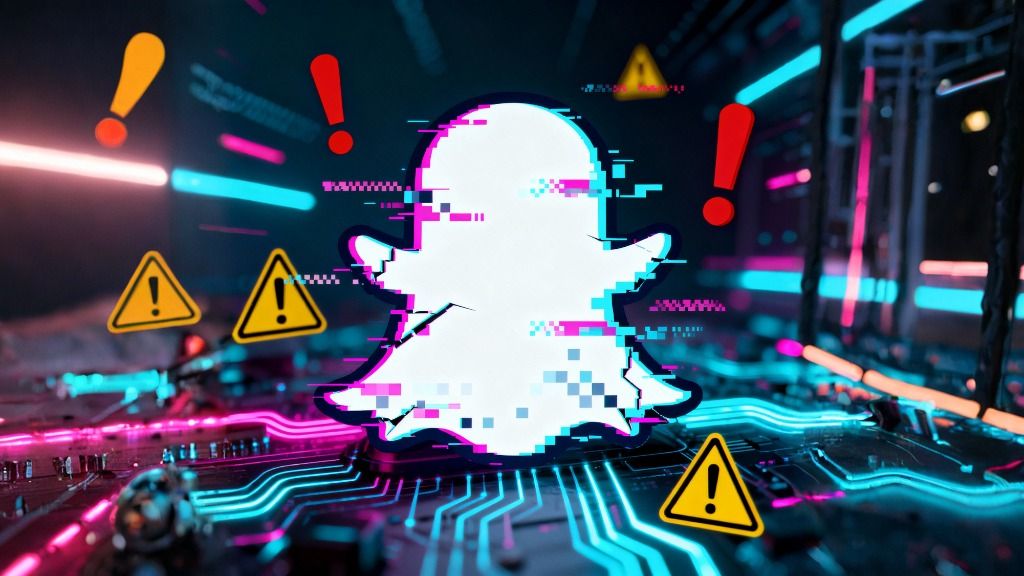Snapchat users worldwide woke up to a nightmare on October 20, 2025—millions couldn't send Snaps, login to their accounts, or access basic features. The culprit? A massive Amazon Web Services (AWS) outage that cascaded across the internet, taking down not just Snapchat, but also Roblox, Fortnite, Duolingo, and dozens of other popular platforms.
But this isn't an isolated incident. Snapchat has been plagued by a growing list of bugs, glitches, and security vulnerabilities that have left users frustrated and concerned about the app's reliability. From mysterious AI chatbot malfunctions to persistent login errors, the popular social media platform is battling technical demons on multiple fronts.
The AWS Outage: When Snapchat Became Collateral Damage
The October 20, 2025 outage wasn't Snapchat's fault—at least not directly. Amazon Web Services, the cloud computing behemoth that powers much of the internet, experienced "increased error rates and latencies" in its US-EAST-1 region. This disruption had a domino effect, bringing down countless services that rely on AWS infrastructure.
Over 13,000 Snapchat users in the United States alone reported issues according to DownDetector, with about 91% experiencing login failures, 6% unable to upload content, and 3% encountering feed loading problems. The outage hit hardest on the East Coast, affecting major cities like New York, Philadelphia, Miami, and Washington DC.
Because Snapchat relies on AWS for critical backend services—authentication, database operations, and media delivery—when AWS goes down, Snapchat's front-end functionality crumbles. Users attempting to sign in or refresh their feeds received repeated error messages or timeouts, consistent with AWS-linked backend failures.
The outage wasn't resolved quickly either. AWS acknowledged the incident and stated they were "working on multiple parallel paths to accelerate recovery," but connectivity issues persisted for hours. Even billionaire Elon Musk couldn't resist weighing in, posting simply: "X works".
The Dreaded C14A Error: What It Means & How to Fix It
Beyond outages, one of the most common and frustrating Snapchat bugs is the infamous C14A error code. If you've ever tried logging into Snapchat only to see "Something went wrong. Please try again later. Support code: C14A," you're not alone.
What Causes the C14A Error?
The C14A error typically appears when Snapchat can't complete the login process due to server connectivity issues. This can happen for several reasons:
Server-side problems: Snapchat's servers are down or undergoing maintenance
Network connection issues: Your internet connection is too slow or unstable
VPN interference: Using a VPN can trigger security flags
Account suspension: Violations of Snapchat's Terms of Service
Too many login attempts: Multiple failed login attempts in a short period
Corrupted cache files: Accumulated app data causing conflicts
Proven Fixes for C14A Error
1. Check Snapchat's Server Status
Before trying anything else, verify if Snapchat is experiencing widespread issues. Visit DownDetector or Snapchat's official support page to see if servers are down. If there's a global outage, you'll need to wait it out.
2. Restart the App and Your Device
Close Snapchat completely (swipe away from recent apps), then reopen it. If that doesn't work, restart your phone. On iPhone, press Volume Up + Side button, swipe to power off, then hold the Side button to turn it back on.
3. Switch Your Internet Connection
Toggle between Wi-Fi and mobile data. If you're on Wi-Fi, switch to cellular data (or vice versa). Disconnect and reconnect to your network. Most importantly, disable any VPN you're using, as it might interfere with Snapchat's servers.
4. Update Snapchat
Open Google Play Store (Android) or App Store (iPhone), search for Snapchat, and tap "Update" if available. Outdated versions often contain bugs that have been fixed in newer releases.
5. Clear Snapchat's Cache
On Android: Go to Settings > Apps > Snapchat > Storage > Clear Cache. Note: This doesn't delete your account data, Memories, or Chats.
On iPhone: Snapchat doesn't offer a direct cache-clear option outside the app when you can't log in, so you'll need to reinstall (see next step).
6. Uninstall and Reinstall
Delete the Snapchat app completely from your device, then reinstall it from the app store. This removes corrupted files and resets the app's camera and network libraries.
7. Check if Your Account Was Suspended
If Snapchat suspended your account due to Terms of Service violations, you'll see the C14A error. Contest your suspension by visiting https://accounts.snapchat.com/accounts/v2/login, logging in, and hitting 'Unlock'. Alternatively, submit an appeal through the Snapchat app.
The My AI Glitch That Freaked Everyone Out
In August 2023, Snapchat users experienced something straight out of a Black Mirror episode. The platform's AI chatbot, My AI—powered by ChatGPT—suddenly posted its own Story showing a video of what appeared to be a wall and ceiling, then stopped responding to messages altogether.
Users flooded social media with concerns. "My Snapchat AI posted a random one second story and isn't replying to me AND IM FREAKED OUT," one user posted on X (formerly Twitter). Another questioned, "Why does My AI have a video of the wall and ceiling in their house as their story?" calling the experience "very weird and honestly unsettling".
Snapchat quickly clarified that it was merely a glitch: "My AI experienced a temporary outage that's now resolved," a spokesperson told CNN. But the incident highlighted anxieties many people harbor about artificial intelligence and raised serious questions about privacy and control.
The My AI feature has faced criticism since its April 2023 launch from parents and users concerned about privacy issues, unsettling interactions, and the inability to remove the feature from their chat interface unless they pay for a premium subscription.
Common Snapchat Bugs & Their Fixes
Beyond major outages and error codes, Snapchat users regularly encounter a variety of frustrating bugs:
Blank Screen Bug
If your Chats appear blank when you open the app, you're experiencing a bug that prevents you from seeing recent conversations.
Fix: Clear the cache from app Settings. If that doesn't work, update to the latest version or delete and reinstall the app.
Messages Not Sending or Loading
When Chats won't send, load, or delete, there are several troubleshooting steps:
Update Snapchat: Ensure both you and your friend are on the latest version
Check Internet Connection: Switch to Wi-Fi or move to a spot with better cell service
Restart the App: Close Snapchat completely and reopen it
Free Up Storage: Clear your Snapchat cache to free up device storage
App Crashing or Not Opening
If Snapchat crashes, freezes, or won't open at all:
Update the app to the latest version
Restart the app by completely closing it and reopening
Restart your device
Check your internet connection and switch between mobile data and Wi-Fi
If issues persist, report the bug through Settings > Bugs and Suggestions > Report a Bug
Camera or Filter Issues
If your camera isn't working or filters aren't loading:
Check camera permissions: Go to device settings, find Snapchat, and ensure camera permission is turned on
Update the app: New filters require the latest version
Clear cache: Remove temporary files that might be causing conflicts
Snapchat's Security Vulnerabilities: A History of Hacks
Snapchat's problems aren't limited to bugs and glitches. The platform has faced serious security vulnerabilities throughout its history.
The 2014 Data Breach
In 2014, personal credentials of 4.6 million U.S. Snapchat users—including usernames and phone numbers—were made public on the Internet by a website called SnapchatDB.info. The attack was a response to previously identified security weaknesses that Snapchat had failed to adequately address.
Security researcher Gibson Security had published a disclosure detailing vulnerabilities in Snapchat's architecture that could lead to data breaches, but the company didn't take sufficient action.
Denial-of-Service Attacks
Also in 2014, researchers discovered that Snapchat was susceptible to denial-of-service attacks that could crash users' devices. Security researcher Jamie Sanchez reported a vulnerability that allowed hackers to overload an inbox with messages, crash iPhones (requiring device resets), and make Android devices noticeably slower.
The FTC Lawsuit
In 2014, the U.S. Federal Trade Commission filed suit against Snapchat with six complaints regarding the app's data security and privacy issues. The company was accused of:
Misrepresenting its privacy policies
Deceiving users about its data collection practices
Failing to implement adequate security measures
Snapchat eventually reached a settlement with the FTC and agreed to implement reasonable security measures, though privacy concerns persist.
2025 Cyberattack Claims
In February 2025, the hacker group SN Blackmeta claimed responsibility for a cyberattack on Snapchat, citing ideological grievances. The group alleged they opposed Snapchat's promotion of explicit content and political bias. Separately, an individual known as "Mr. Hamza" claimed responsibility for a DDoS attack on Snapchat's login portal.
While Snapchat hasn't officially confirmed these attacks, they highlight ongoing security challenges facing the platform.
Privacy Concerns: What Data Does Snapchat Actually Collect?
Understanding Snapchat's data collection practices is crucial for protecting your privacy. According to Snapchat's privacy policy, the platform collects data from three major sources:
Location Data: Snapchat collects precise GPS location data with user permission. This powers features like Geofilters and Snap Maps, but can expose your whereabouts to strangers if privacy settings aren't configured properly.
Camera Information: The app can collect data from Apple's TrueDepth camera, ostensibly to "improve the quality of lenses".
Personal Information: Name, username, password, email, phone number, date of birth, avatar images, and payment information for in-app purchases.
Activity Data: How often you view specific content, what you search for, page views, IP addresses, and cookies.
Messaging and Snap Data: Despite Snapchat's ephemeral messaging promise, messages and Snaps are recorded by the system and can be saved by recipients.
Device/Technical Data: Device type, hardware, software, operating system, apps, browsers, languages, and keyboards you use.
Snapchat is "probably one of the worst platforms for privacy," according to privacy experts on Reddit. The platform is often used as a substitute for SMS, resulting in people sharing highly personal information that Snapchat then saves and potentially sells to advertisers.
How to Report Bugs on Snapchat
If you encounter a bug that the standard fixes don't resolve, you should report it directly to Snapchat:
Tap the gear icon ⚙️ in 'My Profile' to open Settings
Scroll down and tap 'Bugs and Suggestions'
Choose 'Report a Bug'
Select the category where you encountered the bug
Explain the issue in the text box
Add a screenshot if possible
Tap Submit
Alternatively, you can enable "Shake to Report" which allows you to report bugs by physically shaking your device while in the app.
Protecting Your Snapchat Account: Essential Security Tips
Given Snapchat's history of security issues and ongoing bugs, taking proactive security measures is essential:
Enable Two-Factor Authentication: Add an extra layer of security by requiring a verification code in addition to your password.
Adjust Privacy Settings: Control who can send you Snaps, view your Stories, and see your location through Snap Maps.
Be Wary of Screenshots: Remember that Snaps can be screenshotted or photographed with another device. Think before you share.
Avoid Social Engineering Schemes: Never add a phone number or email you don't control to your account. Never share one-time passcodes or login links with anyone.
Use Family Center: Parents can monitor who their teens communicate with on Snapchat without reading actual message content.
Report Suspicious Accounts: If you encounter harassment, bullying, or suspicious activity, report it immediately by pressing and holding on the account and selecting 'Report'.
The Bigger Picture: Why Does Snapchat Keep Breaking?
Snapchat's recurring technical issues stem from several underlying factors:
Cloud Infrastructure Dependency: As the October 2025 AWS outage demonstrated, Snapchat's reliance on third-party cloud services creates vulnerability. When AWS experiences problems, Snapchat becomes collateral damage.
Rapid Feature Development: Snapchat constantly rolls out new features—from AR lenses to AI chatbots—which can introduce bugs and compatibility issues.
Security vs. User Experience Trade-offs: Balancing robust security measures with seamless user experience is challenging. Stricter security can trigger false positives (like the C14A error), while lax security invites hackers.
Scale and Complexity: With hundreds of millions of daily active users generating massive amounts of data, maintaining system stability is an enormous technical challenge.
What Snapchat Needs to Do Better
For Snapchat to regain user trust and improve reliability, the company needs to:
Diversify cloud infrastructure to reduce dependency on a single provider like AWS
Improve communication during outages with real-time status updates
Enhance security measures without creating friction in the user experience
Invest in better bug testing before rolling out new features
Provide more transparent privacy policies that users can actually understand
Offer better customer support with faster response times to bug reports
The Bottom Line
Snapchat's ongoing battle with bugs, outages, and security vulnerabilities reveals the challenges facing even the most popular social media platforms. The October 20, 2025 AWS outage demonstrated how interconnected and fragile modern internet infrastructure can be—when one service fails, millions of users across dozens of platforms suffer the consequences.
For Snapchat users, the message is clear: stay vigilant, keep your app updated, understand what data you're sharing, and know how to troubleshoot common issues like the C14A error. While Snapchat has made improvements since its early security disasters, the platform still has work to do in protecting user privacy and maintaining reliable service.
The next time Snapchat goes down or you encounter a mysterious error code, at least you'll know exactly what to do—and why it's happening in the first place.


